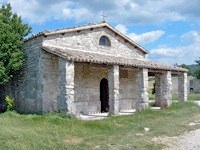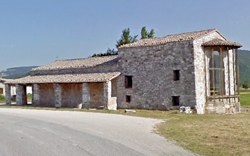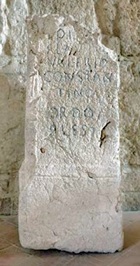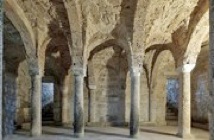
The church of Santa Mari di Plestia stands on the foundations of a Roman building with a colonnaded front, which was probably the “basilica forense”: the remains of its portico were discovered at the level of the church crypt, and the building extended to the left of the church. This basilica seems to have faced the forum of the Roman municipium.
History of the Diocese
Plestia is known to have been a diocese in ca. 500: a bishop of Plestia named Florentius attended synods held in Rome by Pope Symmachus in 499 and again in 502. According to Fabio Bettoni and Maria Romana Picuti (referenced below, at pp. 218-9):
-
“The church ... occupies in all probability,the site of a paleochristian basilica that was the seat of [Bishop Florentius]” (my translation).
According to a 14th century legend of St Raynaldus of Norcia, after the devastation of the area by the Goths, the Emperor Otto I (962-73) absorbed the old dioceses of Tadinum and Plestia into a new diocese of Nocera Umbra. The Emperor Otto III is documented as staying at Plestia in 996 on his return to Germany after his coronation in Rome. He seems to have punished Gualdo at this time for its support of Crescentius: this led Ludovico Jacobilli to conclude that he had also destroyed Plestia, but there is no basis for that assumption (albeit that it is often repeated). The culprit seems to have been an earthquake a few years later, after which the old city suffered a catastrophic inundation.
According to Fabio Bettoni and Maria Romana Picuti (referenced below, at p. 219), the present church was first documented in 1087, when it was a ‘pieve’ (a parish church with a baptismal font). It was securely dcumented agian in 1333, when it was in the territory of Camerino and the diocese of Nocera.
Unfortunately, the church is usually closed.
Present Structure

The portico in front of the church was added in the 15th century. The interior comprised a single nave and a raised apse above a crypt (below). The portico seems to have been added in the 15th century. Unfortunately, the original apse has had to be replaced by a controversial glass and metal structure.
Divus Constantinus (ca. 337 AD)

Di[vo]/ Flavio/ Valerio/ Constan/tino Aug(usto)
ordo/ Ples(tinorum)
It records that the council of Plestia had dedicated something to the deified Emperor Constantine (died 337 AD). Angela Amici (referenced below) suggests that the presence of Constantine’s full name here probably indicates that the inscription slightly pre-dates his death, with the epithet divus applied later. As noted above, other inscriptions found nearby suggest that the cippus had been housed in a temple here that was dedicated to the municipal imperial cult.
It is interesting to note that a temple dedicated to the gens Flavia had been built in nearby Hispellum, probably just before Constantine’s death (sanctioned by the famous Rescript of Hispellum (CIL XI 5265). This temple must have been the main locus for veneration of divus Constantinus in the area. [Could the cippus originally have been been set up in the temple at Hispellum by the Ordo of Plestia, and subsequently returned, perhaps when the temple at Hispellum became a Christian church ??]
Crypt

The lovely crypt contains 14 columns, some of which have been reused.
Read more:
M. Romana Picuti, "Plestia e la Valtopina: Prima e Dopo il 295 avanti Cristo”, in:
F. Bettona and M. Romana Picuti (Eds), La Montagna di Foligno: Itinerari tra Flaminia e Lauretana”, (2007) Spello, pp. 39-55
A. Amici, “Divus Constantinus: Le Testimonianze Epigrafiche”, Rivista Storica dell' Antichità, 30 (2000) 187–216
Return to “Around Foligno”.



